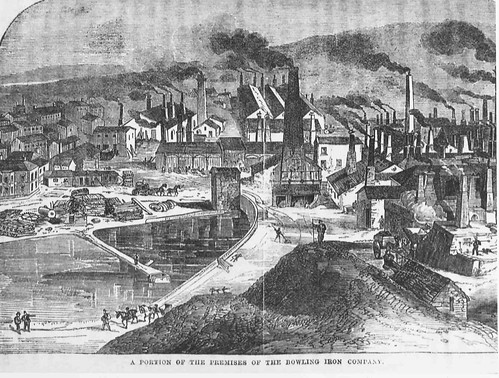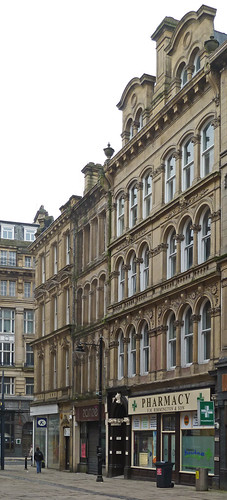 |
| http://www.flickr.com/photos/bradfordlibraries/7202574568/ |
1790 saw the opening of the Low moor Iron works here in Bradford a neglected but very important part not only of our Cities but also of our national heritage .Nationally important in Victorian Great Britain was the production of cast iron.The low moor company produced the counties finest Cast Iron used in cannons that were used in the American Civil war (The Blakely Cannon)
to the building of Isambard Kingdom Brunel’s steamship engine The Great Britain.
http://www.ssgreatbritain.org/story/timeline
The History and Heritage is documented very well in this digital article by Mr Charles Dodsworth and can be found here
http://www.keepandshare.com/doc/4238280/low-moor-history-dodsworth-984k?da=y
F.M. Rimmington - The Sherlock Holmes of Bradford
 |
| http://www.flickr.com/photos/atoach/ |
On Bridge Street in Bradford city centre is a remnant of
Victorian Bradford. While other Victorian Bradford businesses, such as Brown
& Muff’s department store, have come and gone, Rimmingtons Pharmacy has
continued to serve the people of Bradford. It is celebrating 170 years this
year since the business was first established in 1842. Research into the founder
of Rimmingtons has revealed a colourful character, fascinating facts and
a remarkable history. Felix Marsh Rimmington was born in 1818 in the village of
Gateforth, near Selby (North Yorkshire) where hegrew up and attended school. He
served his chemist apprenticeship in Huddersfield and went on to work for a
London chemist called Peter Squire, who at the time was the personal chemist of
Queen Victoria. F. M. Rimmington had established his own chemist shop in
Ivegate, Bradford by 1842, before moving to Bridge Street in 1875 – where it
still is today. Rimmington was no ordinary chemist; he was very passionate and
committed to his profession, going above and beyond the call of duty. For example, in 1862, Rimmington had a letter published in the The
Bradford Observer newspaper, which warned ladies about poisonous dresses made
from tarlatan cloth, dyed with a green colouring containing poisonous arsenic
and copper. Rimmington begged ladies to avoid it as it would harm them.
Rimmington was keen to share his knowledge with other chemists to help them
develop their skills and knowledge. He regularly wrote articles based on his
investigations and research for international science journals, to be read by
other chemists. For example, the medical journal The Lancet in 1865 published his
letter which described his new, successful method of treating tapeworms. He
travelled the length and breadth of the country reading his papers at chemistry
and pharmacy conferences. Rimmington was ahead of his time. By 1855, he was analysing
food to detect adulterations to bring about legal action, years before the
passing of the Sale of Food and Drugs Act in 1875, which made the unadvertised
tampering of food and drugs illegal. By 1857, the local authorities were approaching
Rimmington to acquire his analytical skills and services for criminal investigations.
In 1857, Rimmington helped the police investigate a suspected poisoning and
murder. Rimmington analysed the contents of the deceased’s stomach and detected
a quantity of prussic acid, of which there was enough to cause death. He read
his findings in the court case against the accused. The most famous, or infamous,
case Rimmington was involved in was the
1858 Bradford lozenge poisoning case when sweets were accidently laced with
arsenic, killing twenty and making hundreds extremely ill. Rimmington analysed the suspected poisoned
sweets and worked out what poison was in them and how much. At court, he said
that each lozenge contained nine grains of arsenic, half of which is
enough to kill.
The local authorities officially recognised Rimmington’s
unique skills, expertise and services in 1874 by
appointing him ‘borough analyst’. It was through this role
that the local authorities cracked down on food and drugs adulteration after
the 1875 Sale of Food and Drugs Act. Rimmington was a key cog in enforcing this
law in Bradford and the surrounding districts. He brought about numerous court cases
and prosecutions against offenders by analysing samples and giving evidence in
court. One shocking case he dealt with in 1879 was a sample of ‘butter’ that he
determined to contain 0% of butter. He continued to assist the police with
suspected poisonings by analysing drugs found at crime scenes or examining
bodies. One intriguing case he was involved in as borough analyst was a
suspected Jack the Ripper murder in Bradford. A little boy was found horribly
mutilated and murdered in December of 1888.
Rimmington was called upon to help solve the murder. Rimmington was
Bradford’s very own Sherlock Holmes. Rimmington inspected the crime scene,
examined the drains and sewers in the area for evidence. He found hairs at the
scene, which he indentified to be horse hairs, and a cloth with stains on it,
which he determined to be blood. He examined the stomach contents of the boy
and found traces of currants, suggesting he had just eaten or was eating a
currant bun when murdered. A local man was questioned but no one was ever prosecuted
for the murder. At the time, newspapers insisted Jack the Ripper had travelled
North to commit this murder and to this day, some researchers and historians who specialise in Jack the
Ripper consider this to be a genuine Ripper murder. F. M.
Rimmington died in 1897 and is buried in a family plot at Undercliffe
Cemetery. His son George continued to run the business until an illness around
the time of the First World War prompted him to
advertise for a chemist. A gentleman called Thornton Hirst responded and
eventually took over the business after George’s death around the Second World
War. The Hirst family ran it for three generations and many decades before selling
it to a large pharmacy company, who dropped the Rimmingtons name and rebranded
it as one of their chain pharmacies. It was bought by two Bradford pharmacists
a couple of years ago. They restored it an independent pharmacy and returned it
to the Rimmington name, in order to preserve its unique history and
heritage. Today, the pharmacy continues
F. M. Rimmington’s legacy by dispensing medication, running a free repeat
prescription home delivery service and offering advice to the people of
Bradford. They do this with the same passion and commitment that Rimmington had
170 years ago when he established the pharmacy all those years ago. If you are
ever passing Rimmingtons, pop in to have a browse at old medicinal remedies
from your childhood (such as liquorice bark and sticks, and Potter’s cough
syrup and sweets), look at the old Victorian drug run (shelving) and the
historical display of medicine bottles and equipment while you wait for your prescription.
By Lauren Padgett (Heritage Champion for Rimmingtons
Pharmacy
The above is taken from kbpa weekly (http://kbpa.weebly.com/uploads/1/1/9/7/11976334/voice_july_-_august_2012.pdf
http://www.civicheraldry.co.uk/wriding_ob.html
The Crest opposite is the Crest of the City of Bradford depicts a boar's head sat on top of a well Originating from medieval times the legend of the boar has become local folklore ‘In a wood on the outskirts of Bradford there lived a ferocious Boar, it damaged the land and terrorized the people .So much damage was done by the beast that the Lord of the Manor put a reward up for anyone who killed the beast . In doing so they must take the body of the dead beast to the manor house. It was know the boar liked to drink from the well in the woods so one brave hunter decided to take up the challenge, he lay in wait and sure enough the boar appeared he shot the beast and decided to cut out the tongue to prove he had killed the beast and take it to the lord of the manor to claim his reward .However another hunter who had also heard of the lords offer was passing through the woods and came across the dead beast seizing the opportunity he cut off the boars head and set off to claim the reward. The opportunist hunter arrived before the boars slayer and quickly claimed the reward he failed to explain the absent tongue. A short time after the first hunter arrived with the tongue to claim his reward .The hunter did receive his rightful reward that being a plot of land on the outskirts of Bradford known as Hunt Yard.

In 1066 The Manor of Bradford was valued at four pounds troy weight of silver and in 1070 William the Conqueror laid the whole manor waste it is described as waste in the doomsday book of 1086 "Bradeford" Bradford as it’s know today whose name had derived from the old English Broad and Ford a crossing of the Bradford Beck around a settlement which had grown in Saxon times . The 'Manor of Bradford' was first held by the De Lacy family up until 1311 and then in turn by the Earls of Lincoln, John Gaunt and the Crown before passing into private hands in 1620.
After an uprising in 1070 against the Norman Conquest, Bradford was laid waste but began to extend slowly over the next two-hundred years with the woolen trade gaining in prominence. However The Civil War caused a decline in the industry and The Sieges of Bradford began in December 1642 with the first siege .http://www.siegesofbradford.co.uk/
In November of that year Two Gentlemen had arrived in Bradford and had began to recruit and train a army of men from the area the gentlemen were Lord Fairfax and Sir Thomas Fairfax. Many responded enthusiastically to the call.

No comments:
Post a Comment